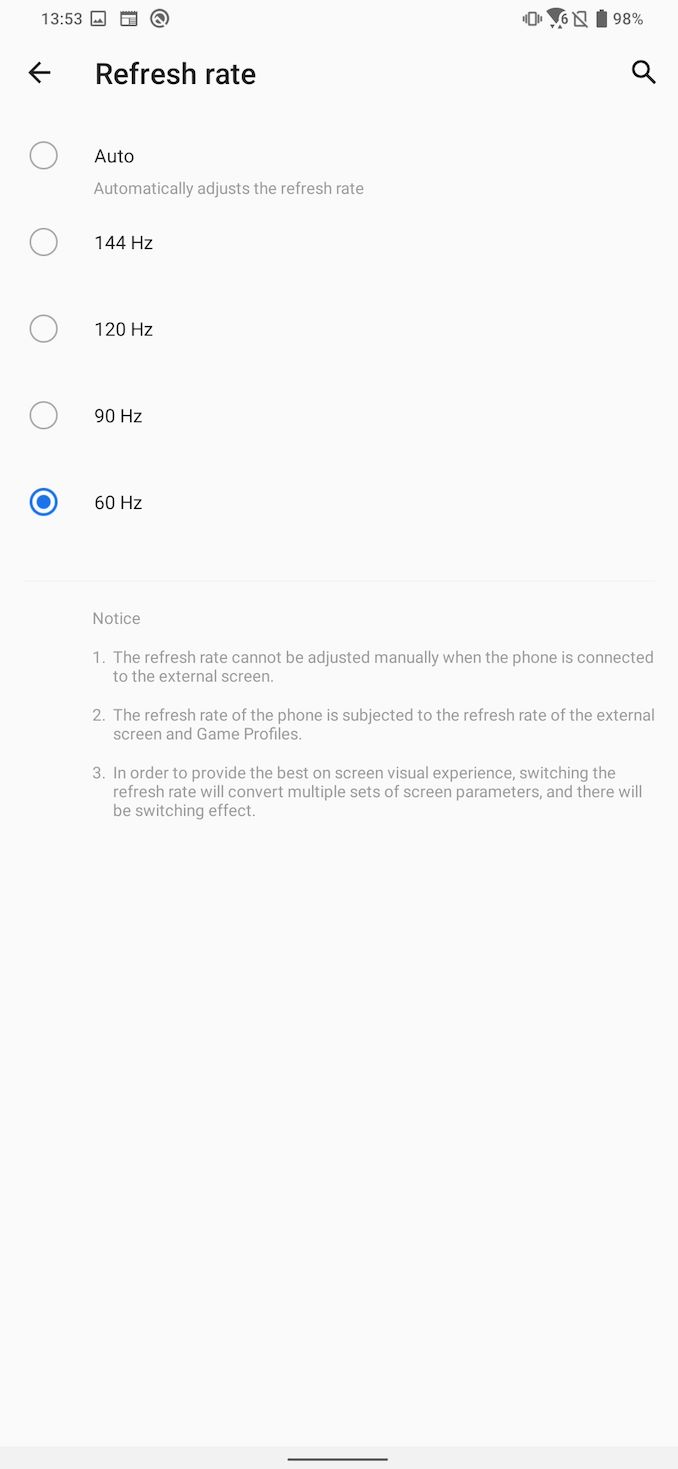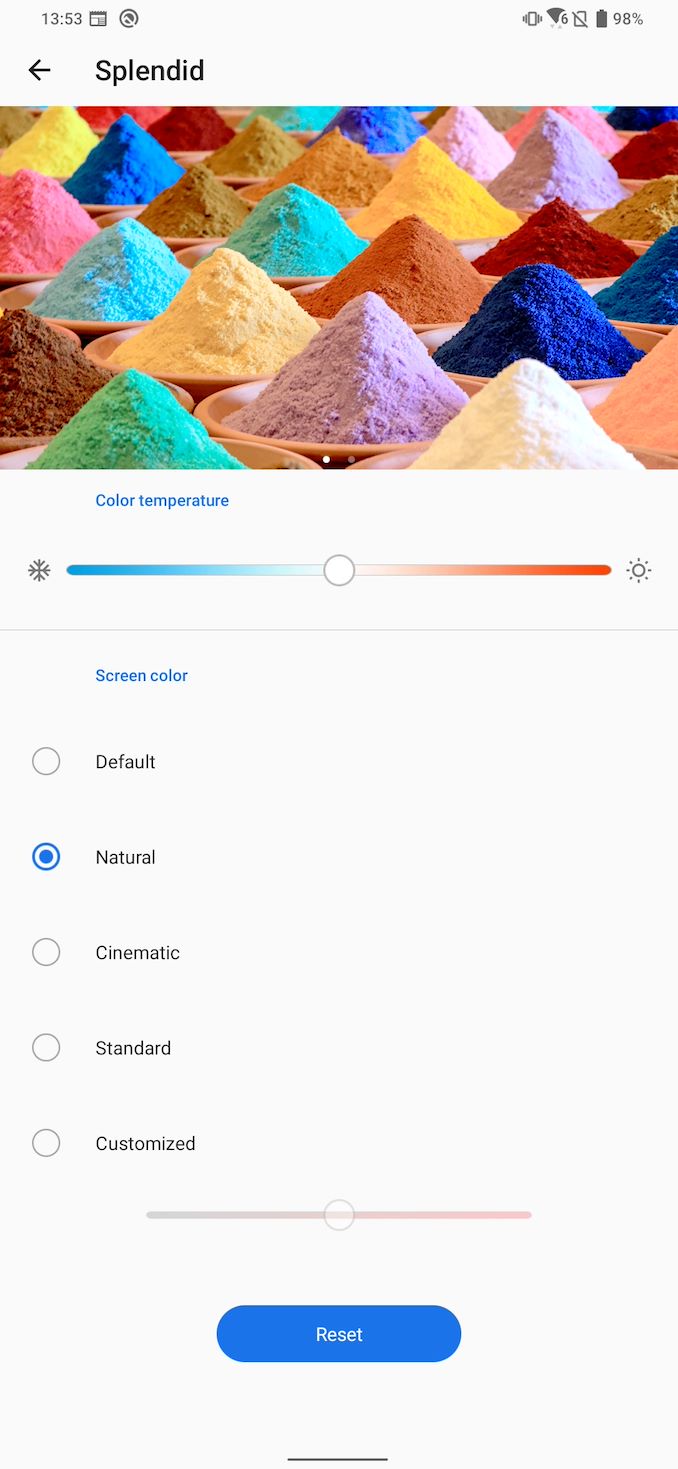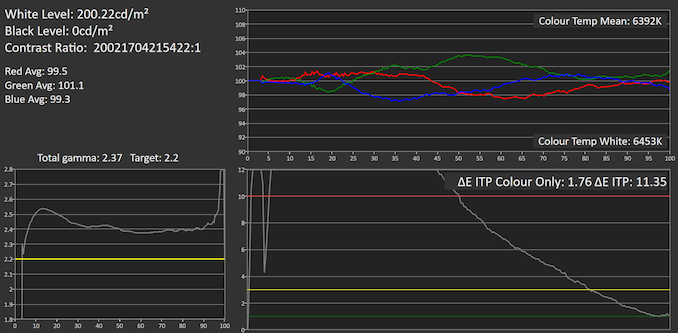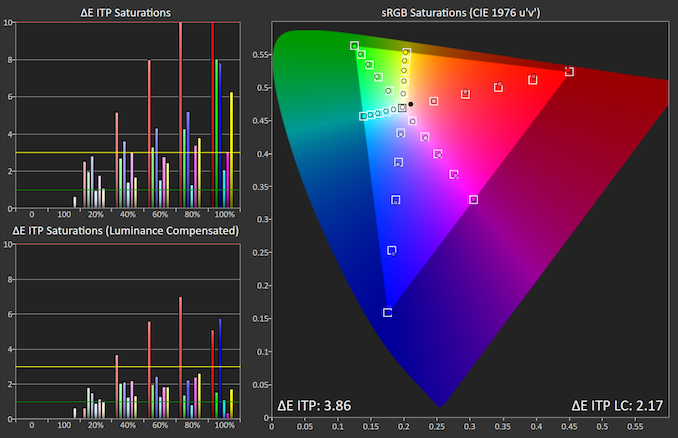The ASUS ROG Phone III Review: A 144Hz 6000mAh Beast With Caveats
by Andrei Frumusanu on August 28, 2020 9:00 AM EST- Posted in
- Mobile
- Smartphones
- Snapdragon 865
- ROG Phone III
Display Measurement
The display on the ROG Phone III is an OLED panel that features a 1080p resolution and a very high refresh-rate of up to 144Hz. Although it was something quite extraordinary back in 2019, in 2020 it’s doesn’t showcase the same kind of spec-list advantage versus the 1440p 120Hz panels by some other competitors in the market.
The phone gives you the options to operate at 60, 90, 120 or 144Hz which is quite wide array of selections. Unfortunately, much like other super-high refresh-rate panels on the market, going beyond 90Hz comes at a quite larger power consumption cost.
Colour settings on the ROG Phone III are very varied and customisable, giving you four different predefined display gamut selections. The “standard” profile is the calibrated sRGB target with a default colour temperature near 6500K, so that’s what we measured and what I would recommend users to choose when looking for accurate display colours.
We move on to the display calibration and fundamental display measurements of the ROG Phone III screen. As always, we thank X-Rite and SpecraCal, as our measurements are performed with an X-Rite i1Pro 2 spectrophotometer, with the exception of black levels which are measured with an i1Display Pro colorimeter. Data is collected and examined using Portrait Display's CalMAN software.

In terms of brightness, the ROG Phone III fares well, with manual brightness reaching up to around 423cd/m², whilst when in adaptive brightness mode this boosts up to 652cd/m² full-screen white (100% APL) when under bright ambient light conditions.
In the standard display profile, colour temperature is quite good at the high levels, tracking whites at 6453K. At the mid-levels there’s a bit too much greens.
Although greyscale colour accuracy is quite excellent with a dEITP of only 1.76, the overall error rate when including luminosity is quite bad in our results here, and the reason for that is that the phone is targeting a much higher gamma of around 2.4. Unfortunately this aspect is valid for all colour profiles of the phone and there’s no way to fine-tune or change this.
What this means is that mid- and low-levels will appear darker than they are meant to.
Saturation accuracy against the sRGB target is excellent, with only minor deviations which are exaggerated by the higher gamma target of the display profile.
The Gretag MacBeth chart of common colour tones and skin tones is also quite accurate in terms of colour saturations and hues, however the off-target luminosity because of the higher gamma is the main reason the total dEITP error rate is quite high at 8.57.
Overall, the screen of the ROG Phone III is excellent, although not class-leading. It’s not quite as high resolution or as bright as some competitors, but it still fares very well, and it’s currently amongst a very small number of phones which can claim a 144Hz refresh-rate, although the actual benefits of that over 120Hz devices is rather minor.
Colour accuracy is good, although you’d have to get used to that higher gamma target which produces darker colour tones.

















71 Comments
View All Comments
Medstar1 - Saturday, August 29, 2020 - link
Personally I've never given wireless audio a try. I was first introduced to the Quad DAC on my LG V20 years ago and it made the headphone jack a part of my "must have" list for phones every since. Another reason may be the fact that when I listen to music I am stationary and not engaged in other activities. I don't listen to music when I'm out, say hiking, because it kind of nullifys the point of being out in nature. I don't do it while I'm out and about in the city because I want to be situationally aware of my surroundings at all times. So bottom line I just haven't found the need to go wireless at this stage.habs01 - Saturday, August 29, 2020 - link
Having a 3.5mm jack doesn't prevent you from using bluetooth if that's what you like. It doesn't work the other way around.flyingpants265 - Sunday, August 30, 2020 - link
You've given in to the inconvenience of Bluetooth, you mean.And you've given into the cost.
Red john - Sunday, August 30, 2020 - link
The problem of wireless headset means you are required to charge a new gadget along with your mobile phone. And we can get better audio quality output with half of the price in wired than wireless headsetsflyingpants265 - Sunday, August 30, 2020 - link
Not required. You can use USBC headphones. Just strongly encouraged by marketing.s.yu - Wednesday, September 2, 2020 - link
Required if you use magnetic charging cables, because your sole C port will be stuck with a magnetic adaptor in it.. And those sell pretty well, the market is expanding in fact.s.yu - Wednesday, September 2, 2020 - link
I can tell you that Sony's flagship overear is sorely inadequate and PHA55BT doesn't drive low impedance CIEMs as well as my phone with its integrated DAC through the 3.5mm. No BT earphone/headphone is known to surpass the former and no adaptor is known to surpass the latter. End of discussion.hemedans - Friday, August 28, 2020 - link
it has two usb type C ports, use one for wired type c earphoneLord of the Bored - Saturday, August 29, 2020 - link
But I want to use normal headphones, not my GBA SP toy phones.flyingpants265 - Sunday, August 30, 2020 - link
So buy an adapter to carry around everywhere and degrade your sound quality (noise etc from contacts/soldering/bad shielding)Remember to pay for that too.